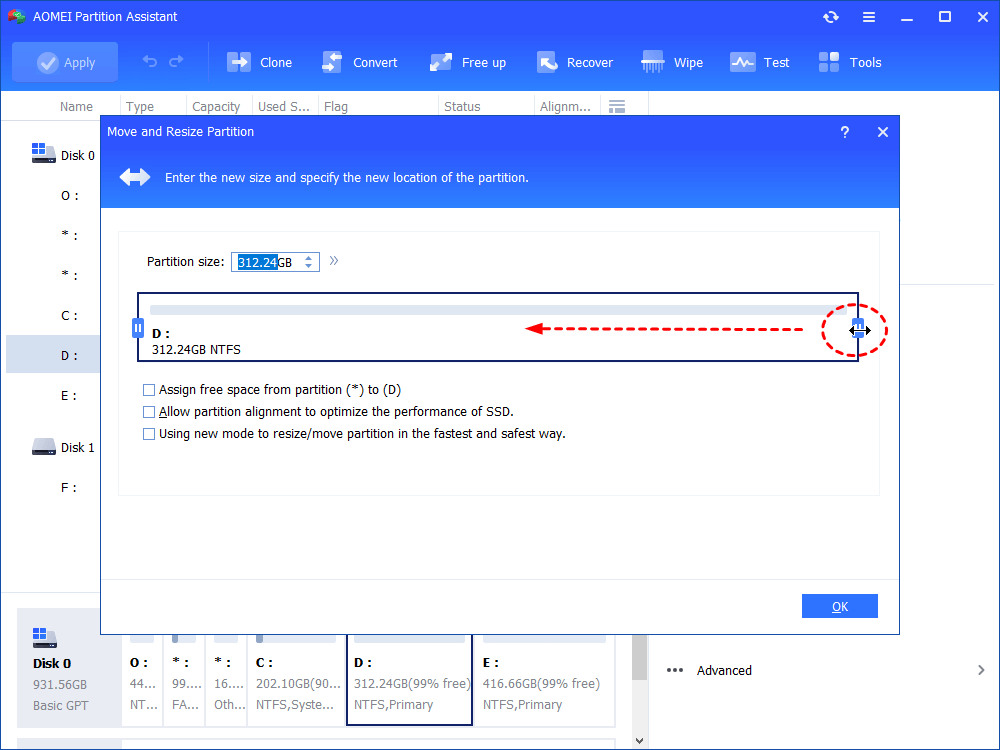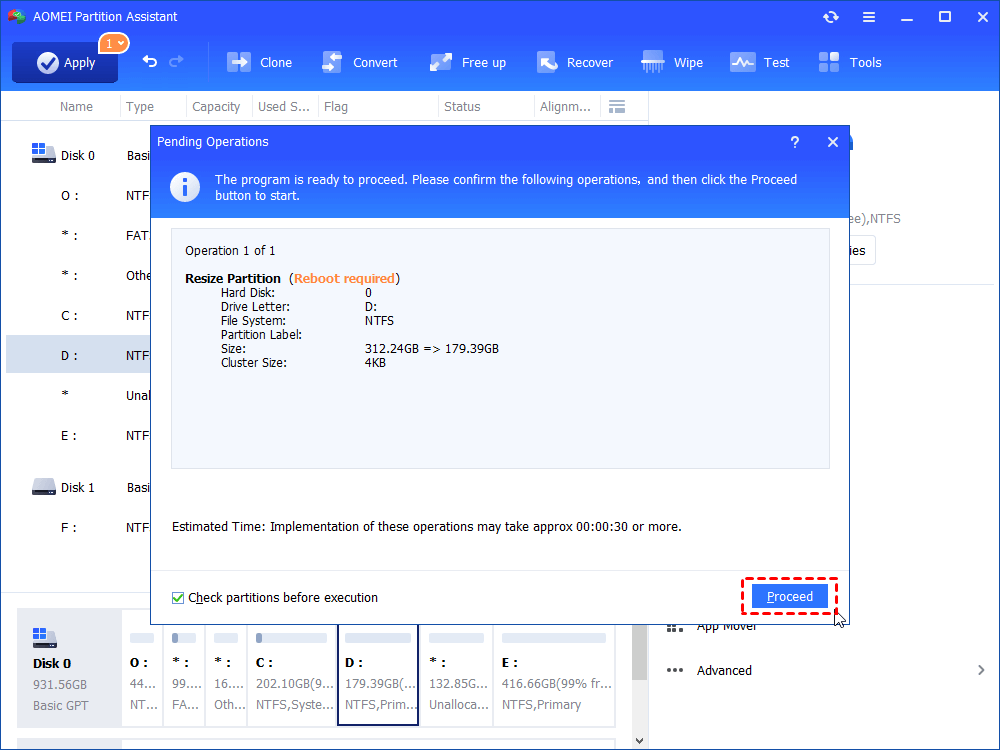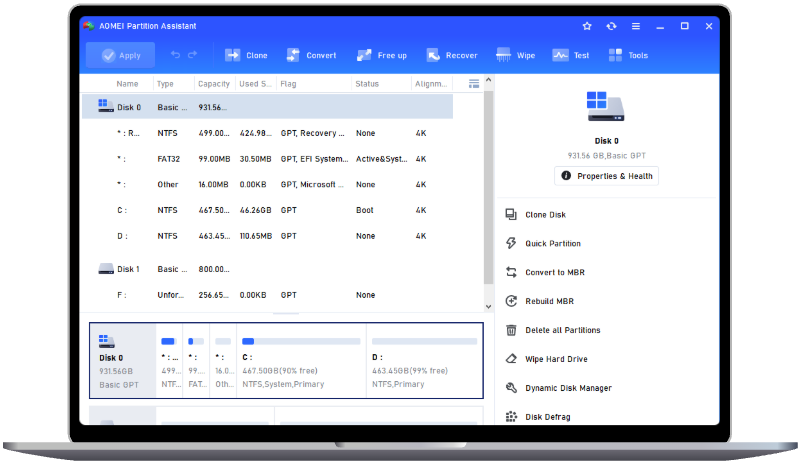Windows Repartition Size: What Is the Best Size For Windows?
It is easy to perform Windows repartition size. This article will explain what is the best partition size for Windows 10 and how to easily resize it.
What is the best partition size for Windows 10?
Choosing the right partition sizes for Windows 10 is important for keeping your system running smoothly. People often look for advice on this to avoid running out of disk space or causing system problems in the future, just like this user from Reddit.
How many GB should I partition for Windows 10? Building a PC with a 1TB SSD (Samsung 970 Evo Plus) but not sure how many GB to partition for Windows. What is the best partition size for Windows 10? Can I resize this system partition in the future if I have any extra need?
- Question from Reddit
Proper partitioning helps with performance, organization, and makes sure your system can grow without issues. So, what is the best partition size for Windows 10? The "best" size depends on usage, hardware, and partitioning goals. Below are guidelines based on common scenarios:
1. Minimum Requirements
-
32-bit Windows 10: 16 GB (Microsoft’s baseline).
-
64-bit Windows 10: 20–32 GB (official minimum), but practical usage requires more.
2. Recommended Sizes for Typical Users
| Usage Scenario | Recommended C: Drive Size | Key Considerations |
|---|---|---|
| Basic Use (browsing, office apps) | 70–100 GB | Reserve 30–40 GB free space for updates and temporary files. |
| General Use (programs, light gaming) | 100–150 GB | Accommodates OS files (~25 GB), apps, and future updates. |
| Gaming/Content Creation | 200–300 GB | Large games (e.g., 100+ GB titles) and editing software require ample space. Store media files on separate drives. |
| Small SSD Users (120–256 GB) | Use entire SSD for C: | Avoid partitioning to maximize performance and space efficiency. |
3. Critical Factors Influencing Partition Size
How many GB should I partition for Windows 10? Many factors will influence the result. Windows 10 itself occupies ~20–25 GB, but hibernation (hiberfil.sys) and virtual memory (pagefile.sys) can add 10–40 GB, depending on RAM. In addition to this, there are some other factors:
-
File System:
-
NTFS: No practical size limits, ideal for large partitions.
-
FAT32: Avoid for system drives due to 32 GB creation limit in Windows tools (use third-party software for larger FAT32 partitions).
-
-
Partitioning Scheme:
-
MBR: Limited to 2 TB disks and 4 primary partitions.
-
GPT: Supports disks up to 9.4 ZB and 128 partitions, essential for modern large drives.
-
To ensure your system runs efficiently, it's a good idea to reserve 10–20% of the C: drive for updates and temporary files. This helps keep everything running smoothly. You might also want to store personal files and non-essential apps on separate partitions or drives, which can help reduce clutter on the C: drive. Lastly, it’s best to avoid over-partitioning your hard drive, as too many partitions can waste space and slow down access times due to how hard drives function.
How to perform Windows repartition size?
AOMEI Partition Assistant is a comprehensive disk manager that can help you easily resize partitions with various options.
Option 1. 1-Click Adjust Space
The "1-Click Adjust Space" feature offers a straightforward and efficient method for managing free space on your disks. By simply dragging the edges of partitions, you can resize them, allowing for quick modifications to your disk layout. AOMEI Partition Assistant also enables you to adjust multiple partitions simultaneously, streamlining the process and making it easy.
The Best Windows Disk Partition Manager and PC Optimizer
Step 1. Install and launch AOMEI Partition Assistant. Right-click a partition (here is D: partition) you want to adjust space and select "1-Click Adjust Space".
Note: It cannot select unallocated space to adjust because the feature is just for partition space adjustment. If there is unallocated space and you want to use it to expand a partition, you can use the feature "Merge Partition".
Step 2. If you want to use the space on F: to expand D: you can simply drag the dot near the partition F: head backward to shrink the partition F: and enlarge the partition D: simultaneously. Then click "OK". You can simultaneously drag the dot near the partition C: tail forward to shrink the partition C: so the D: will also be enlarged with the space of C: at the same time. In this case, you can adjust all partition space (C:, D:, and F:) on the disk.
Step 3. You can preview the operation by viewing the "Pending Operations". To commit the "Pending Operations", please click "Apply" and "Proceed".
Step 4. The process will start and you can check the progress. It might take time to finish the operation.
Step 5. Wait for the operation to be finished. After it is completed successfully, you will find D: is enlarged and both D: and F: are adjusted.
Option 2. Resize partition
Its Resize Partition feature also makes it easy to repartition Windows size, even if unmovable files are blocking the process. Unlike Windows Disk Management, this tool is designed to overcome limitations and provide a more efficient and user-friendly way to manage disk partitions. With it, you can quickly extend or shrink a partition without any limitation.
The Best Windows Disk Partition Manager and PC Optimizer
Step 1. Open AOMEI Partition Assistant.
Step 2. Right-click on the partition or volume to be shrunk and select Resize/Move Partition.
Step 3. In the next screen, drag the slider leftwards to shrink the partition.
Step 4. Click OK to preview the partition layout. If no problem, click Apply to run the operation.
Further reading: How to repartition hard disk?
When you have different plans for a used hard drive, you may need to repartition it. AOMEI Partition Assistant also offers such a feature. After adjusting the partition size, you can use this software to create multiple customized partitions simultaneously with the feature of quick partition:
AOMEI Partition Assistant is a user-friendly tool that simplifies disk management tasks. It allows you to create partitions from unallocated space or by dividing existing ones. You can also merge partitions and split them as needed. Unlike Windows' built-in Disk Management, this software lets you resize partitions on NTFS and FAT32 file systems.
Summary
This article introduces how to perform Windows repartition size with sharing other useful information. In short, choosing the right partition size for Windows 10 is important for keeping your system running smoothly. The best size depends on how you use your computer and your storage needs. Tools like AOMEI Partition Assistant can help you easily manage and resize partitions, making the process much simpler. By following these guidelines, you can keep your system organized and efficient without any issues.




